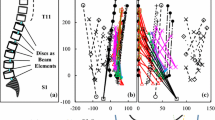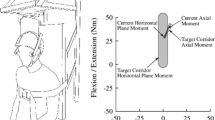Abstract
Spine musculoskeletal models used to estimate loads and displacements require many simplifying assumptions. We examined how assumptions about subject size and vertebral positions can affect the model outcomes. Head and neck models were developed to represent 30 subjects (15 males and 15 females) in neutral posture and in forward head postures adopted while using tablet computers. We examined the effects of (1) subject size-specific parameters for head mass and muscle strength; and (2) vertebral positions obtained either directly from X-ray or estimated from photographs. The outcome metrics were maximum neck extensor muscle moment, gravitational moment of the head, and gravitational demand, the ratio between gravitational moment and maximum muscle moment. The estimates of maximum muscle moment, gravitational moment and gravitational demand were significantly different when models included subject-specific vertebral positions. Outcome metrics of models that included subject-specific head and neck size were not significantly different from generic models on average, but they had significant sex differences. This work suggests that developing models from X-rays rather than photographs has a large effect on model predictions. Moreover, size-specific model parameters may be important to evaluate sex differences in neck musculoskeletal disorders.








Similar content being viewed by others
References
Ackland, D. C., Y. C. Lin, and M. G. Pandy. Sensitivity of model predictions of muscle function to changes in moment arms and muscle-tendon properties: a Monte-Carlo analysis. J Biomech 45:1463–1471, 2012.
Amevo, B., D. Worth, and N. Bogduk. Instantaneous axes of rotation of the typical cervical motion segments: A study in normal volunteers. Clin Biomech (Bristol, Avon) 6:111–117, 1991.
Anderst, W. J., W. F. Donaldson, 3rd, J. Y. Lee, and J. D. Kang. Cervical motion segment percent contributions to flexion-extension during continuous functional movement in control subjects and arthrodesis patients. Spine 38:E533, 2013.
Anderst, W. J., W. F. Donaldson, J. Y. Lee, and J. D. Kang. Cervical spine intervertebral kinematics with respect to the head are different during flexion and extension motions. J Biomech 46:1471–1475, 2013.
Bolsterlee, B., A. N. Vardy, F. C. van der Helm, and H. E. Veeger. The effect of scaling physiological cross-sectional area on musculoskeletal model predictions. J Biomech 48:1760–1768, 2015.
Cazzola, D., T. P. Holsgrove, E. Preatoni, H. S. Gill, and G. Trewartha. Cervical spine injuries: a whole-body musculoskeletal model for the analysis of spinal loading. PLoS ONE 12:e0169329, 2017.
Christophy, M., N. A. Faruk, J. C. Senan, and O. M. O’Reilly. A musculoskeletal model for the lumbar spine. Biomech Model Mechanobiol 11:19–34, 2012.
Clauser, C. E., J. T. McConville, and J. M. Young. Weight volume and center of mass of segments of the human body. Yellow Springs: Wright-Patterson Air Force Base, 1979.
Cook, D. D., and D. J. Robertson. The generic modeling fallacy: Average biomechanical models often produce non-average results!. J Biomech 49:3609–3615, 2016.
Correa, T. A., and M. G. Pandy. A mass-length scaling law for modeling muscle strength in the lower limb. J Biomech 44:2782–2789, 2011.
Desantis Klinich, K., S. M. Ebert, C. A. Van Ee, C. A. Flannagan, M. Prasad, M. P. Reed, and L. W. Schneider. Cervical spine geometry in the automotive seated posture: variations with age, stature, and gender. Stapp Car Crash J 48:301–330, 2004.
Frobin, W., G. Leivseth, M. Biggemann, and P. Brinckmann. Sagittal plane segmental motion of the cervical spine. A new precision measurement protocol and normal motion data of healthy adults. Clin Biomech (Bristol, Avon) 17:21–31, 2002.
Ghezelbash, F., A. Shirazi-Adl, N. Arjmand, Z. El-Ouaaid, A. Plamondon, and J. R. Meakin. Effects of sex, age, body height and body weight on spinal loads: Sensitivity analyses in a subject-specific trunk musculoskeletal model. J Biomech 49:3492–3501, 2016.
Hajihosseinali, M., N. Arjmand, and A. Shirazi-Adl. Effect of body weight on spinal loads in various activities: a personalized biomechanical modeling approach. J Biomech 48:276–282, 2015.
Knarr, B. A., and J. S. Higginson. Practical approach to subject-specific estimation of knee joint contact force. J Biomech 48:2897–2902, 2015.
McGill, S. M., and R. W. Norman. Partitioning of the L4–L5 dynamic moment into disc, ligamentous, and muscular components during lifting. Spine 11:666–678, 1986.
Myers, C. A., P. J. Laz, K. B. Shelburne, and B. S. Davidson. A probabilistic approach to quantify the impact of uncertainty propagation in musculoskeletal simulations. Ann Biomed Eng 43:1098–1111, 2015.
NASA. Anthropometric Source Book, vol. 1: Anthropometry for Designers [Reference Publication 1024]. Hanover, MD: National Aeronautics and Space Administration, Scientific and Technical Information Office, 1978.
Netto, K. J., A. F. Burnett, J. P. Green, and J. P. Rodrigues. Validation of an EMG-driven, graphically based isometric musculoskeletal model of the cervical spine. J Biomech Eng 130:031014, 2008.
Nevins, D. D., L. Zheng, and A. N. Vasavada. Inter-individual variation in vertebral kinematics affects predictions of neck musculoskeletal models. J Biomech 47:3288–3294, 2014.
Reitman, C. A., K. M. Mauro, L. Nguyen, J. M. Ziegler, and J. A. Hipp. Intervertebral motion between flexion and extension in asymptomatic individuals. Spine 29:2832–2843, 2004.
Sato, F., M. Odani, Y. Miyazaki, K. Yamazaki, J. Osth, and M. Svensson. Effects of whole spine alignment patterns on neck responses in rear end impact. Traffic Inj Prev 18:199–206, 2017.
Straker, L., R. Skoss, A. Burnett, and R. Burgess-Limerick. Effect of visual display height on modelled upper and lower cervical gravitational moment, muscle capacity and relative strain. Ergonomics 52:204–221, 2009.
Suderman, B. L., and A. N. Vasavada. Neck muscle moment arms obtained in-vivo from MRI: effect of curved and straight modeled paths. Ann Biomed Eng 45:2009–2024, 2017.
Thuresson, M., B. Ang, J. Linder, and K. Harms-Ringdahl. Mechanical load and EMG activity in the neck induced by different head-worn equipment and neck postures. Int J Ind Ergonomics 35:13–18, 2005.
Valente, G., L. Pitto, D. Testi, A. Seth, S. L. Delp, R. Stagni, M. Viceconti, and F. Taddei. Are subject-specific musculoskeletal models robust to the uncertainties in parameter identification? PLoS ONE 9:e112625, 2014.
Valero-Cuevas, F. J., M. E. Johanson, and J. D. Towles. Towards a realistic biomechanical model of the thumb: the choice of kinematic description may be more critical than the solution method or the variability/uncertainty of musculoskeletal parameters. J Biomech 36:1019–1030, 2003.
Van den Abbeele, M., F. Li, V. Pomero, D. Bonneau, B. Sandoz, S. Laporte, and W. Skalli. A subject-specific biomechanical control model for the prediction of cervical spine muscle forces. Clin Biomech (Bristol, Avon) 51:58–66, 2018.
Vasavada, A. N., J. Danaraj, and G. P. Siegmund. Head and neck anthropometry, vertebral geometry and neck strength in height-matched men and women. J Biomech 41:114–121, 2008.
Vasavada, A. N., S. Li, and S. L. Delp. Influence of muscle morphometry and moment arms on the moment-generating capacity of human neck muscles. Spine 23:412–422, 1998.
Vasavada, A. N., D. D. Nevins, S. M. Monda, E. Hughes, and D. C. Lin. Gravitational demand on the neck musculature during tablet computer use. Ergonomics 58:1–15, 2015.
Wu, S. K., L. C. Kuo, H. C. Lan, S. W. Tsai, and F. C. Su. Segmental percentage contributions of cervical spine during different motion ranges of flexion and extension. J Spinal Disord Tech 23:278–284, 2010.
Wu, G., S. Siegler, P. Allard, C. Kirtley, A. Leardini, D. Rosenbaum, M. Whittle, D. D. D’Lima, L. Cristofolini, H. Witte, O. Schmid, and I. Stokes. ISB recommendation on definitions of joint coordinate system of various joints for the reporting of human joint motion–part I: ankle, hip, and spine. Int Soc Biomech 35:543–548, 2002.
Zajac, F. E. Muscle and tendon: properties, models, scaling, and application to biomechanics and motor control. Crit Rev Biomed Eng 17:359–411, 1989.
Zheng, L., J. Jahn, and A. N. Vasavada. Sagittal plane kinematics of the adult hyoid bone. J Biomech 45:531–536, 2012.
Zheng, L., G. Siegmund, G. Ozyigit, and A. Vasavada. Sex-specific prediction of neck muscle volumes. J Biomech 46:899–904, 2013.
Acknowledgements
The authors thank Roseann Amundsen and Darin Porter of Pullman Regional Hospital Radiology for their assistance with radiographs, and Victor Small, Theodore Gross, Zane Duke and Chandler Shannon for data analysis. Funding was provided by the Office Ergonomics Research Committee and National Science Foundation (CBET #0748303).
Conflict of interest
The authors confirm that there have been no conflicts of interest interfering with the preparation of this manuscript.
Author information
Authors and Affiliations
Corresponding author
Additional information
Associate Editor ter E. McHugh oversaw the review of this article.
Electronic supplementary material
Below is the link to the electronic supplementary material.
Rights and permissions
About this article
Cite this article
Vasavada, A.N., Hughes, E., Nevins, D.D. et al. Effect of Subject-Specific Vertebral Position and Head and Neck Size on Calculation of Spine Musculoskeletal Moments. Ann Biomed Eng 46, 1844–1856 (2018). https://doi.org/10.1007/s10439-018-2084-9
Received:
Accepted:
Published:
Issue Date:
DOI: https://doi.org/10.1007/s10439-018-2084-9




